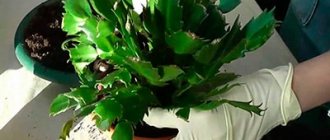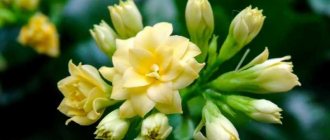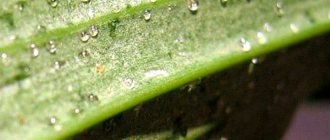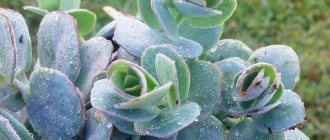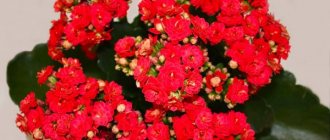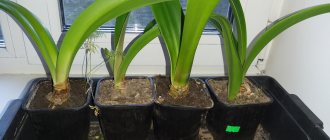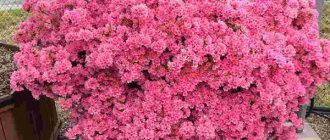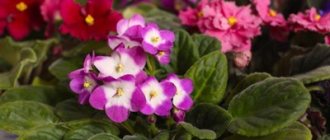Florists at home grow many species of such a diverse and at the same time unpretentious plant as Kalanchoe. On the windowsills today you can see the spectacular inflorescences of Kalanchoe Blossfeld, the sharp, baby-strewn leaves of Kalanchoe Degremon, as well as bluish, felt-covered, variegated and purple bushes that are outwardly dissimilar, but belong to the same genus, native to the subtropics and tropics of Africa, Australia and Asia. Fans of indoor floriculture are attracted to Kalanchoe by its unusual appearance, ease of care, numerous methods of propagation and the ability to achieve flowering of this plant.
If in nature different types of Kalanchoe can reach from 20 cm to 4 meters in height, then in potted culture these perennial herbaceous shrubs do not exceed half a meter, grow well and regularly delight with the appearance of inflorescences.
In order for plants from fairly warm parts of the world to feel good on the windowsill in an apartment, even such an unpretentious crop as Kalanchoe at home cannot be done without care, replanting, proper watering and providing other living conditions. Most of the rules for growing Kalanchoe for indoor plant varieties are general. This concerns the issues of planting young bushes obtained from cuttings, leaves or daughter rosettes and replanting mature plants that need to expand their “living space”.
Is it necessary to replant Kalanchoe during flowering?
With good care, Kalanchoe grows quite quickly, and not only the above-ground part grows, but also the root system. This means that from time to time the plants need to be replanted into a larger pot or several Kalanchoes must be planted in separate containers. How to replant Kalanchoe? And when is it better to carry out this procedure in order to injure the plant less and not interfere with its flowering?
Often Kalanchoe of such decorative species as Kalandiva and Blossfelda come into the house already in bloom. At the same time, flower growers are faced with a difficult problem. Is it worth immediately replanting Kalanchoe, which has inflorescences of all shades?
If the bush is replanted during the flowering period, this will become stressful for the plant, to which it will respond by dropping the buds and taking a long, painful acclimatization.
It is better to postpone all manipulations with the bush until all the flower stalks have withered and been cut off. Until this time, it is necessary to create acceptable temperature conditions for the Kalanchoe and provide the indoor plant with proper watering and lighting. Before planting Kalanchoe, manufacturers must add a certain amount of long-term fertilizer to the soil, which should be enough until the end of flowering.
The only truly serious problem at this time is the possible drying out of the soil in a small shipping pot. This can be solved by placing the plant in a pot of suitable size, and on the surface of the soil make a mulching layer of nut shells, sawdust, pebbles or other material. The first Kalanchoe transplant at home is best done in the spring, when daylight begins to arrive, flowering ends, and the plant is ready to gain strength and grow.
Folk signs
Kalanchoe is suitable for breeding for energetic and purposeful people. This is the kind of flower that will be conducive to achieving success and conquering new heights.
But for those who suffer from indecision, it would be useful to place a flowerpot with a succulent in their home. This will help you gain confidence in your abilities.
If you have problems in your family life, place a pot of flowers on the windowsill, and your feelings with your spouse will get a second wind. And for unmarried people, the fleshy leaves will help attract a groom.
If you notice that the Kalanchoe has begun to fade, you should know that damage has been caused to you or your home.
Replanting Kalanchoe at home
As in subsequent years, the first transplant is carried out with extreme caution.
Before planting Kalanchoe in a new container, pay attention to the condition of the root system and stems of the Kalanchoe.
Such an inspection is necessary due to the sensitivity of Kalanchoe roots to stagnation of moisture and excessive watering.
- If dark spots of rot or mold are noticed on the roots, such areas are removed, and the pruning areas are treated with crushed coal.
- If the damage affects the stems, then the shoot below the damaged tissue will have to be cut off, so that later its healthy part can be used as a cutting, and so the Kalanchoe can be replanted.
The plant is removed from the pot along with the earthen lump, being careful not to lose the existing soil or damage the roots. To facilitate the process, shortly before transplanting, the Kalanchoe is well watered. This is extremely useful if you have to plant Kalanchoe, for example, by removing from under a large bush small daughter plants, rooted cuttings or rosettes that have fallen from the leaves.
Then the lump is carefully placed on a drainage sprinkled with soil, the empty spaces around the plant are filled with soil, compacting it a little. Finally, level the soil surface and mulch with a layer of pebbles, crushed shells or large wood chips. This method of caring for Kalanchoe during replanting at home will reduce moisture loss and prevent mold from developing, and will also prevent children and falling Kalanchoe leaves from contacting the ground and taking root.
If this is not done, after some time you will need to replant the Kalanchoe, since under the adult plant you will definitely find a mass of small rosettes that take away both nutrients and moisture from the bush.
Why do Kalanchoe leaves turn yellow, curl, dry out and fall off?
Kalanchoe leaf tips dry out.
There are several reasons for this phenomenon, depending on the nature and location of the affected leaves.
- If these are only the top ones, then the plant does not have enough sun light.
- If only the lower ones - you allowed the soil to dry out and have not watered the Kalanchoe for a long time. And also, perhaps, there is a too hot battery under his pot. Therefore, change its place to a cooler one.
A few more reasons:
- tightness of the pot,
- the plant is aging, which means it’s time to pinch off its healthy shoots/leaves and take rejuvenation measures,
- infestation with aphids, if a similar situation occurs in the summer, and the plant itself lives on the balcony or in your garden.
Choosing a pot for Kalanchoe
A new pot for the bush is taken a couple of centimeters larger than the previous one. The optimal size of a slide for Kalanchoe is from 12 to 18 cm, depending on the variety and variety.
Flowering varieties do not like the proximity of other plants, even related species. But if an excessively wide pot is chosen for replanting Kalanchoe of such plants, this can lead to the growth of the green part of the bush and failure to flower. You can get out of the situation by planting a couple of young rosettes on the Kalanchoe, obtained from apical petioles from the same bush or from children. Indoor flower beds made from several plants, simultaneously producing inflorescences of different shades, will look even more impressive.
Kalanchoes that naturally grow in arid deserts, such as tomentose varieties or Kalanchoe Lucia, coexist well with other plants with a similar lifestyle. From these types of Kalanchoe you can create indoor gardens that imitate the corners of the rocky desert of southern Africa or Madagascar, which will become a unique addition to the interior. The best material for a pot is unglazed ceramics, in which all pores are preserved, which means the plant breathes, and from the soil naturally Excess moisture is removed.
Before transplanting the Kalanchoe into the selected pot, the container is washed with hot water and treated with a solution of potassium permanganate.
What should you focus on?
But before moving on to the basic rules for choosing a pot for a plant, it would be a good idea to familiarize yourself with the features of the Kalanchoe life cycle. This flower tolerates temperature changes well and loves sunlight. It constantly needs irrigation, but this plant should be watered very carefully, as it often dies from acidification of the soil. This factor should be the main one when choosing the size of the container.
Purchased small Kalanchoes must be transplanted into permanent pots after two weeks.
It is very important that the root system of the plant receives oxygen and develops normally. Constant loosening of the soil partially ensures this. But at the same time, it is also necessary to choose the right material for the pot.
Small Kalanchoe seedlings are quite vulnerable to all kinds of pests and diseases. And all gardeners know that plants often begin to get sick after transplantation due to insufficiently disinfected pots or incorrectly selected pots from an environmental point of view. This should also be taken into account.
Soil for Kalanchoe
If the soil in a transport pot with Kalanchoe is predominantly a mixture of peat and coconut fiber, then in a permanent place the plant will be more comfortable in nutritious, loose soil of a more harmonious composition, which must be maintained during subsequent replantings of the bush. This technique allows you to minimize the adaptation of Kalanchoe to new conditions.
For Kalanchoe, soil with an acidity level of 5.0 to 6.5 is preferred. This indicator can be achieved by adding dolomite or lime flour to the soil.
Soil suitable for Kalanchoe must be well-permeable to oxygen and water, provide proper nutrition, and not contain components that are toxic or dangerous to the plant:
- As soil, you can take a ready-made soil mixture for flower plants, diluting it by a quarter with clean sand.
- For Kalanchoe plants accustomed to harsh desert conditions, it is possible to use soil for succulents.
But it is better to prepare the soil for Kalanchoe yourself, mixing equal parts of high-quality humus, garden soil and coarse sand.
To add structure to the soil, add one part of a mixture of brick or expanded clay chips and crushed coal.
Since there are a lot of plant varieties, but all of them are quite unpretentious to the proposed soils, a mixture of:
- 4 parts purified peat;
- 2 parts of turf land;
- 1 part river sand.
To protect the plant from dangerous pathogens of fungal infections and Kalanchoe pests remaining in the humus and soil, the soil must be steamed or heated in the oven before planting. Don't forget about drainage. This is an essential part of arranging a Kalanchoe pot. The drainage layer, at least 2 cm thick, is made of fine expanded clay or crushed brick.
After transplantation, Kalanchoe undergoes acclimatization, during which the plant requires support. Such special care for Kalanchoe after transplantation at home is feeding, which is carried out twice a month until the beginning of autumn.
Flower pests
Pests on this flower appear much less frequently than diseases, but this phenomenon still occurs. Insect pests of Kalanchoe include aphids, lepidoptera, mites and mealybugs. All of them suck the sap from the plant, weakening its strength and making it vulnerable to other threats.
Pseudomonas mealybug
This is a small insect that deprives the plant of sap during its life cycle. The second negative factor is the spread of black mold fungus. The colony develops quite quickly and, in the absence of timely treatment, leads to the death of the plant.
A typical symptom of the presence of a pest is a waxy coating on the leaves and stems. The fight is to use mineral oil for spraying. If one branch is heavily infected, it is better to remove it. It is important to check the plant and soil for the presence of the pest before purchasing.
Shchitovka
The insect has an elongated body covered with a shield. Males are smaller than females, who practically do not move, but only cover the eggs. Scab and scales are characteristic of the appearance of the pest, as they are quite large and visible to the naked eye.
The spread of scale insects on the plant causes wilting. Later, the leaves turn yellow and fall off, the plant slows down its growth and stops producing flower stems. The presence of this pest can cause sooty mold to appear, making the situation even worse.
The fight consists of frequent spraying of the plant, since pests do not like water. Adults are treated with alcohol to better separate them from the leaf, and then collected. Then the plant is sprayed with a soap solution. Instead, insecticides can be used to control pests. General purpose drugs are suitable, since there are no individual recipes.
Aphid
Aphids are a very common insect to attack plants as they can enter the house on other flowers or simply be sucked in through a window. Aphids live on the undersides of leaves as small black or green dots. The pest sucks out the juice and injects poison into the flower. It also coats the plant with a sticky substance that closes the pores and prevents the leaves from breathing.
It is important to know how to get rid of aphids on Kalanchoe, otherwise the flower will soon die. Check the plant periodically for pests and make sure there is no deformation or yellowing.
The first step is to remove the damaged areas along with the colonies. The remaining branches and leaves are sprayed with insecticides - 4 times a month. A milder form of treatment is potassium soap: 20 g of soap is diluted in 1 liter of water. The resulting solution is used to wash the plants, and the soil must be covered before treatment. If you don’t have potassium soap, laundry soap will do - it’s not as effective, but it will also help cope with the problem.
Ticks
Sucking insects living on the underside of the leaf blade. Recognized by the appearance of the web. Prefers warm and dry air. On the plant, the appearance of the pest is manifested by yellowing of the leaves, which then harden and curl.
Mites can be controlled in the same way as aphids. For spraying, the preparations “Akarin”, “Fitoverm” and similar are used.
After eliminating the source of the problem, the plant should be revived and stimulated to new growth. As a preventative measure, avoid drafts, temperature changes, excessive humidity or excessive dryness.
When you know what diseases and pests are attacking, you can respond to worsening conditions in time and take appropriate measures. It is important to check leaves and shoots regularly as they are the first signs of problems. Once the problem is corrected, the plant should be revived again. You should also follow the rules of follow-up care, since such a “home doctor” will be useful in any family.
Drainage preparation
When choosing the thickness of the drainage, you should be guided by the following rule: the larger the drainage hole, the thinner the drainage layer is made; The smaller the diameter of the holes at the bottom of the pot, the thicker the drainage layer should be.
The drainage layer can be made from the following components: expanded clay for house plants - it is necessary to choose the diameter so that it does not fall out through the drainage holes; natural materials - gravel, crushed stone, river pebbles, ceramic chips, broken bricks. Thanks to the long process of budding, Kalanchoe blooms for quite a long time.
Watering issues
The key to caring for a Kalanchoe flower at home is proper watering. As a rule, this plant does not need abundant and frequent watering, but it is necessary to be able to correctly distribute the moisture provided to the plant throughout the year, since the flower’s water needs are not constant, but change.
- In hot summer weather, the plant must be watered more often to avoid drying out. Since frequent watering of a plant with large amounts of water can lead to rotting of its root system, it is necessary to increase the frequency of watering, and not the volume of water during one watering. Also, the pot with the plant must be equipped with drainage holes. It is recommended to water either early in the morning or late in the evening. You need to be careful not to get water on the leaves, since droplets of liquid when exposed to sunlight act like an optical magnifier, which can damage the foliage. On hot summer days, it is recommended to maintain a watering frequency of 3-4 times a week.
- During the cold season, there is no need for frequent watering of the plant, since the evaporation of water from its leaves is minimal, and the leaves themselves have the appropriate supply of liquid necessary for the life of Kalanchoe. At this time, the gardener only needs to monitor the condition of the soil; as soon as it becomes completely dry, the plant should be watered.
